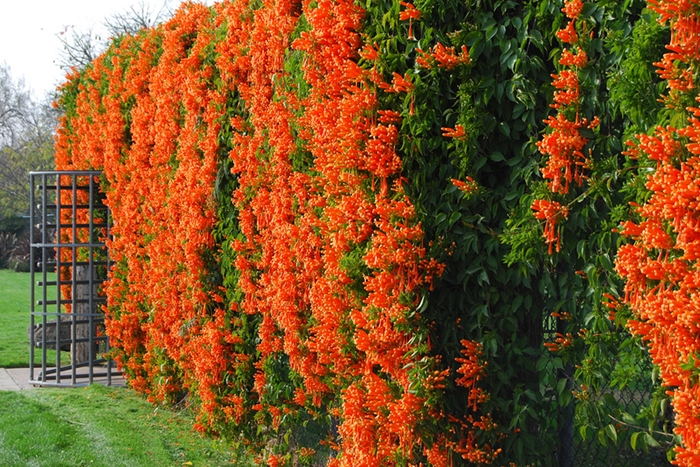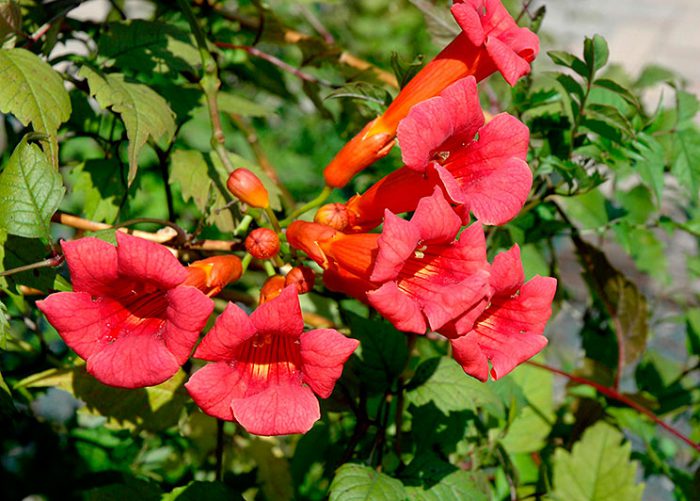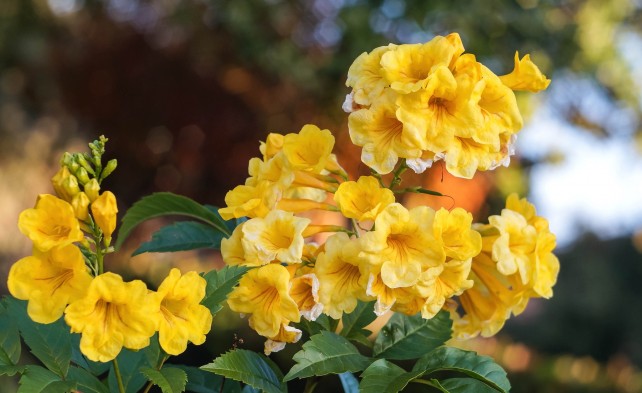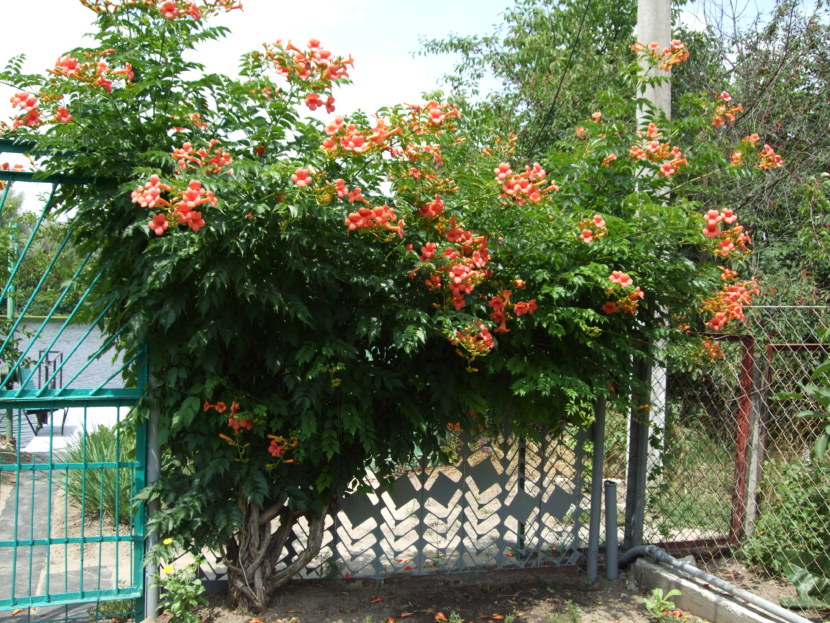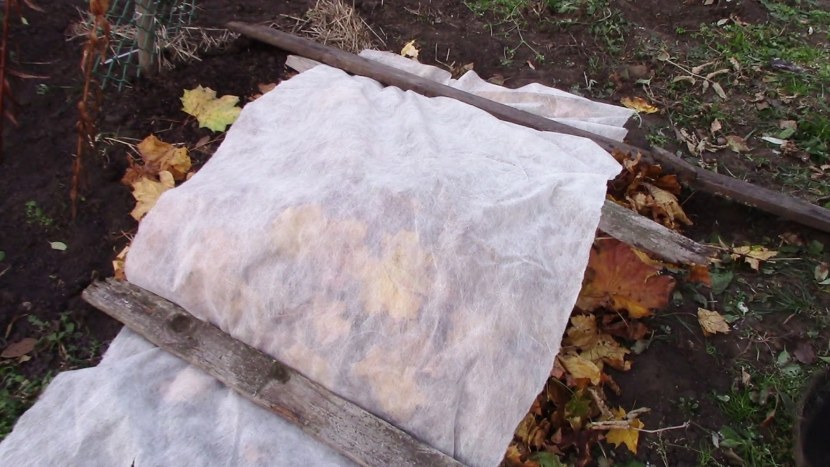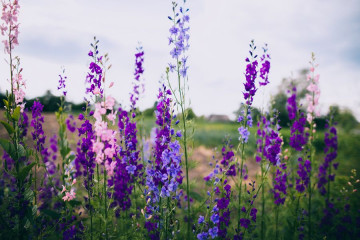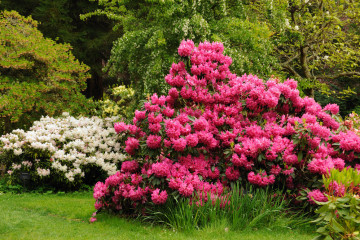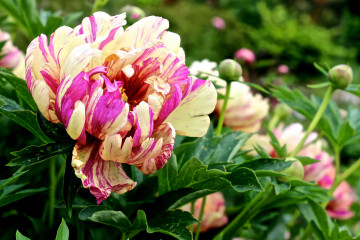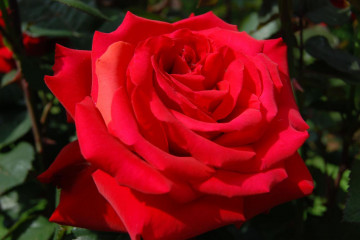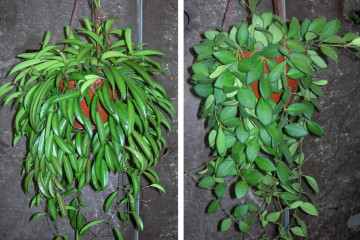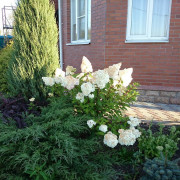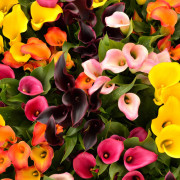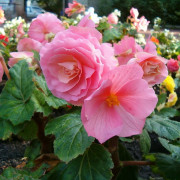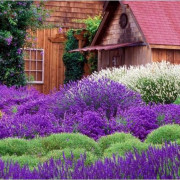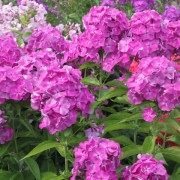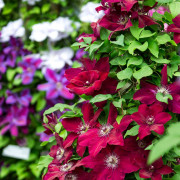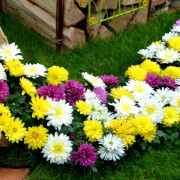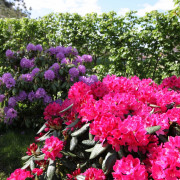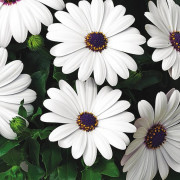Campsis liana (Campsis) - rooting, large-flowered, hybrid species
Content:
Campsis liana is a beautiful, fast-growing plant that has been used since the 17th century to decorate the outer walls of houses, gazebos and gardens. Branched shoots at the time of flowering are covered with bright flowers of large sizes. The plant is popularly known as "tekoma".
Features of Kampsis
Campsis is a perennial flower with a well-developed rhizome, which not only grows in depth, but also grows on the sides, covering a vast territory.
What family does it belong to
Tekoma kampsis belongs to the Bignonium family.
Briefly about the history of appearance
There is no exact data on how the vine appeared. The homeland of the plant is China and North America.
Plant characteristic
The campsis flower has the following description:
- shoots - long, covered with smooth bark, as the plant grows up, they become stiff and acquire a burgundy-brown hue;
- internodes have aerial roots and several leaves;
- seedlings have from 7 to 11 leaf plates of an oval or ovoid shape;
- the leaves are green, with jagged edges, the surface is glossy on the front side, the back side is covered with a thick small fluff;
- inflorescences are numerous, on each peduncle from 2 to 8 flowers;
- flowers are tubular, up to 8 cm in diameter;
- the corolla consists of 5 petals, fused at the base, the edges are bent, the color is varied - golden, crimson, pink.
The color of the petals depends on the variety of the vine.
Kampsis classification
The genus of Kampsis is not numerous, it includes only 3 species of vines.
Campsis rooting (Campsis radicans), or bignonia rooting (Bignonia radicans)
It is one of the most common. The rooting Kampsis has a high winter hardiness, for which it enjoys special respect among gardeners. Specifications:
- shoots from 7 to 9 m long;
- petiole contains from 9 to 11 leaf plates, pubescence on the reverse side is rare;
- flowers with a diameter of 6 cm;
- the tube is bright copper, the petals are painted red at the bend.
Large-flowered campsis (Campsis grandiflora), or Chinese campsis, or Chinese bignonia (Bignonia grandiflora)
This is a kind of flexible vine that braids the support in a short time and densely. There is no fluff on the back of the leaves. The diameter of the flower, narrow in shape, is about 6 cm. The color is rich copper.
Large-flowered campsis is distinguished by a modest length of shoots, it grows like a spreading bush. Prefers moderate temperatures with abundant diffused lighting.
Campsis hybrid (Campsis hybrida)
A young species of liana, which is distinguished by large flowers. The shoots are long, reaching from 4 to 6 m. The plant has high frost resistance and excellent decorative characteristics.
Varieties that are in great demand among gardeners
Each species has several varieties, but only a few of them are actively used in landscape design.
Judy
Campsis Judy has small flowers, painted in burgundy-golden color. The diameter of the inflorescences is from 6 to 8 cm. The leaves are covered on the reverse side with a plentiful and dense downy. The maximum height of campsis radicans is 10 m.
Flamenco
The vine reaches a length of 5 m. The plant blooms from July to October. The color of the flamenco petals is bright burgundy.
Flava
Blooms from July to October, the shade of bells is light yellow.
Gorgeous
The variety differs in that it curls weakly. In appearance, it looks more like a shrub. The stems are long and slender. The shade of the flowers is copper.
Golden
It blooms with a delicate golden color.
Early
It begins to bloom in June. The flowers are large, light burgundy.
Dark purple
The color of the petals is a scarlet shade with a purple tint.
Kampsis breeding methods
Campsis breeding is easy. It is planted with seeds, cuttings, layering and root shoots.
Growing from seeds
Planting material is harvested in the fall, after flowering. The fruits are long seed pods.
Cuttings
Seed stocking is carried out from June to July.
How to propagate by root shoots
The root growth of a flower quickly spreads, and therefore it is used for flower reproduction. The shoots are dug up along with the roots and planted in fertile soil in the spring. A few years after planting, the plant will begin to bloom.
Reproduction by layering
Before deciding how to propagate Kampsis by layering, it must be borne in mind that this method is not necessary, since the plant gives a large amount of high-quality growth.
Seed planting by seedling method
The seed method is rarely used, because after such a planting, flowering occurs no earlier than 5-7 years later.
Time to board
Planting seeds in the ground is carried out in early spring, in early March.
Choice of capacity
A shallow wooden box is selected, into which fertile soil is poured.
Soil and seed preparation
The soil for seeds should be loose, with a neutral acidity index. The soil is well moisturized. Seeds do not require preliminary preparation for planting. The seed is buried no more than 5 mm, and is covered with a thin layer of earth on top.
A box with seeds is exposed to the sun, and kept in a warm room at night. Moistening of the soil is carried out as the earth dries up.
Seedling care
Seedlings appear in about 20-30 days. Watering - as needed. The soil must be kept slightly moist, but not overflowed, otherwise the young roots will begin to rot. When 5-6 leaves appear on the shoots, they can be transplanted to a permanent place.
Dive
Young shoots ready for transplanting are carefully removed from the soil. It is important to keep a clod of soil around the roots so that the plant can easily undergo transplanting. A hole is prepared to such a depth into which the root system will completely enter. The land must first be fed with complex fertilizers. The seedlings are placed in a hole, covered with earth and lightly tamped and watered.
Features of planting in a seedless way in open ground
Experienced gardeners recommend using cut shoots with their further rooting. Young branches are cut, which can be divided into pieces at least 10 cm long. They need to be put in water for several hours with the addition of a growth stimulator, and then planted in fertile soil.
Features of care in the garden
Campsis care and planting in the open field is not difficult, does not require the creation of specific conditions.
What conditions do capsises like
The plant loves well-lit places, without drafts and strong winds.
What is the plant afraid of
Despite the fact that the vine can withstand drought, prolonged lack of watering will negatively affect the decorative properties of the plant. Frequent overflow is also detrimental to the flower; it can provoke rotting of the root system.
Watering
You need to water the vine sparingly, as the soil dries. When the leaves fall off, watering should be reduced to a minimum. During the summer heat, the plant should be watered often, at least 1 time a week.
Mulching
Mulching is necessary to maintain optimum soil moisture, preventing it from drying out. Helps mulching avoid root overheating. Sawdust is used.
Loosening
You need to loosen the soil slightly after each watering. This measure will provide the roots with the necessary aeration, which will help the young flower to take root.
Top dressing
Campsis planting and caring for which even a novice gardener can do, does not need fertilizers. To ensure abundant and long-lasting flowering, it is recommended to feed the liana with fertilizer with nitrogen and phosphorus in the composition.
When and how it blooms:
The flowering period for each variety of vines is different. The beginning of the appearance of flowers and the duration of flowering depend on the climate and weather. Campsis in the Urals, which is not difficult to grow, blooms later due to the cold spring weather. In a strip with a temperate and warm climate, flowering begins in June and July.
Types of flowers
Depending on the variety, flowers can be small, no more than 5 cm in diameter, and large, up to 8 cm.
Flower shapes
The flower consists of several, mainly 5 petals, which are connected at the base, the edges are bent to the sides.
Flowering period
The tree liana blooms all season.
Changes in care during the flowering period
It is easy to care for a vine during its flowering period - it is enough to increase watering. As the flowers wither, they need to be removed.
Post-flowering care
When the plant stops blooming, watering is reduced, formative and cleansing pruning is carried out.
Pruning
Pruning is done in the spring, until the buds appear. Dry and damaged branches are removed. Dry shoots are cut off - the development of the vines is very rapid, and therefore the plant can spread so much in a year that it loses its decorative properties.
One of the reasons why Kampsis does not bloom is the presence of a large number of old shoots.They need to be removed, thereby forcing the plant to sprout new branches. Flowers appear only on young branches.
Preparation for wintering
Sanitary pruning is carried out not only in spring, but also before wintering.
Preparation for a dive
If Kampsis is homemade, in a pot, it must be transplanted every year with an increase in the volume of the pot. A pick is carried out in the spring. Watering stops a week before the transplant. Fertile soil is being prepared in a new flowerpot.
Possible growing problems:
Liana is a completely unpretentious plant, but sometimes the gardener has to face some difficulties. These are diseases, pests, lack of flowering or slow development.
Pests
Liana is interesting only for aphids, which periodically attack flowers. To get rid of the parasite, the plant must be treated with insecticides. For prevention, these funds are used in June.
Diseases
Root rot can occur due to over-watering and persistently high humidity. To restore the plant, it is necessary to remove the damaged parts of the root system and normalize watering.
Signs of improper care
Lack of mulching, due to which the roots overheat, excessive watering or lack of moisture - all this leads to the fact that the vine does not develop well. She rarely has shoots, they are very weak. Flowering is weak and short, the shade of flowers is faded. The leaves turn pale, wither.
Campsis is a beautiful liana, which is loved for its active stretching of shoots and bright, long and abundant flowering. Caring for it is not at all difficult, and therefore even a novice gardener can use it to decorate the walls of a house, a gazebo, a veranda.
